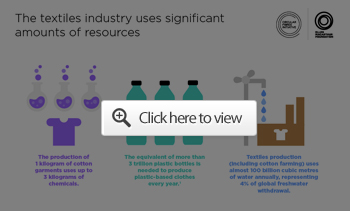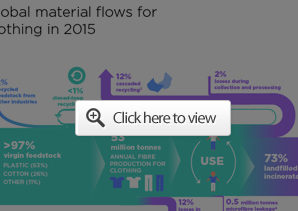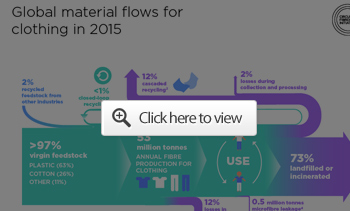Care What You Wear — Fixing Fast Fashion
More Information
30 Tips in 30 Days Designed to Help You Take Control of Your
Health
This article is part of the 30 Day Resolution Guide series. Each day a new tip will be added designed to help you take control of your health. For a complete list of the tips click HERE
By Dr. Mercola
In recent years, the true cost of cheap clothing and so-called “fast fashion” has become better understood, and with that knowledge, a call to change is being sounded. Investigations reveal the clothing industry is a significant source of environmental pollution — according to some estimates it’s the fifth-most polluting industry in the world1 — and excessive consumption only adds to these problems.
So, while in the past the fashion industry has largely skated below the radar, environmentalists and environmentally-minded industry insiders alike are now starting to really hone in on these problems. As noted by the Ellen Macarthur Foundation:2
“The time has come to transition to a textile system that delivers better economic, societal, and environmental outcomes. The report ‘A new textiles economy: Redesigning fashion’s future’ outlines a vision and sets out ambitions and actions — based on the principles of a circular economy — to design out negative impacts and capture a USD 500 billion economic opportunity by truly transforming the way clothes are designed, sold, and used.”
In the past, I had not really given much thought to the clothes I’m wearing, and was shocked to learn about the health and environmental damage occurring from “fast fashion.” I’ve now dedicated myself to wearing and supporting a responsible and regenerative movement to “Care What You Wear,” by developing the Dirt Shirt — organic clothing grown and sewn in the USA — and SITO; organic clothing produced responsibly outside the U.S.
This year, give some serious thought to cleaning up your wardrobe. Remember, being a conscious consumer does not stop at food and household products. Your clothing can be a source of hazardous chemicals, and cheaply made fast fashion items take a tremendous toll on the environment and the people working in the industry. As a consumer, your choices will help guide the garment industry toward more humane and environmentally sane manufacturing processes.
Clothing Sales Are at an All-Time High
According to the featured report, created by the Ellen Macarthur Foundation’s recently launched Circular Fibres Initiative,3,4 while sales of clothing are at an all-time high, utilization of clothing has dramatically diminished, which makes sense considering you can only wear so many items in a year. Most of us also have maybe a handful of items we really like and end up wearing repeatedly.
Between 2000 and 2015, clothing sales soared, doubling from 50 billion units to 100 billion. As a result, the average number of times a garment is worn before being discarded significantly dropped. As noted in the featured article, “steady production growth is intrinsically linked to a decline in utilization per item, leading to an incredible amount of waste.”
Estimates suggest more than half of all clothing purchases are discarded in less than a year. As crazy as it may sound, one British fashion company reminds its customers that a dress will only remain in a woman’s wardrobe for five weeks!5 As noted by Lucy Siegle, who made that stunning observation,6 “The way we get dressed now has virtually nothing in common with the behavior of previous generations, for whom one garment could be worn for decades.”
The result of treating clothing as single-wear disposables is a rapidly growing waste problem that is tough to remedy. Landfills burn the equivalent of one garbage truck full of garments each and every second, and since fabrics are typically dyed and/or treated with toxic chemicals, it’s all essentially toxic waste. Less than 1 percent of discarded textiles are recycled and reused. Growing chemical and plastic pollution is yet another side effect of fast fashion.
“The use of substances of concern in textile production has an important impact on farmers’ and factory workers’ health as well as on the surrounding environment. During use, it has been recently estimated that, half a million tons of plastic microfibers shed during washing ends up in the ocean and ultimately enters the food chain …” the foundation notes.
>>>>> Click Here <<<<<
Source: Ellen Macarthur Foundation
Introducing a New Textile Economy
To address these downsides, the featured report presents a new form of textile economy in which textiles “re-enter the economy after use and never end up as waste.” The four cornerstones of this new economy involve:
- Phasing out toxic substances used in textile production and redesigning materials to prevent shedding of microfibers
- Changing the way clothing is designed, marketed and used to move away from disposable fashion
- Improving textile recycling
- Transitioning to renewable inputs to prevent the waste of nonrenewable resources

>>>>> Click Here <<<<<
Source: Ellen Macarthur Foundation
Fashion designer Stella McCartney, who cohosted the launch of the report, said:
“What really excites me about ‘A new textiles economy: Redesigning fashion’s future’ is that it provides solutions to an industry that is incredibly wasteful and harmful to the environment. The report presents a roadmap for us to create better businesses and a better environment. It opens up the conversation that will allow us to find a way to work together to better our industry, for the future of fashion and for the future of the planet.”
The Care What You Wear Campaign
Indeed, we simply must begin to care about what goes into the clothes we wear, which is why I’m participating and donating proceeds from my Dirt Shirts — made from GOTS certified 100 percent organic cotton, sustainably grown in Texas — to the Care What You Wear campaign.
To learn more about this project, check out dirtshirt.org and changingclothes.org. Gone are the days when fashion was all about looking good. Today, there’s a real movement toward fashion that also does good in and for the world. As explained by Marci Zaroff, founder of the first organically certified textile mill in the U.S.:
“It’s not that different from the Farm to Table Movement, where people are saying, ‘Where is my food coming from? How is it being grown and produced?’… We’re waking up to our source inside. We’re awakening to that desire to know what we’re putting in and on our bodies as an extension of ourselves. It’s not just what you eat. It’s also what you wear that is a part of you. We need to be thinking about fiber no differently than we are about food.”
The upshot of this is that responsibly made clothing, made with nontoxic dyes (or no dyes) and organic materials, also feel great. There’s a real difference in quality, and when a piece of clothing is of superb quality, the urge to toss it after a few wears is greatly diminished. In fact, high-quality items often get better with use, opposed to turning into a misshapen, discolored, ill-fitting, worn-out mess after a few washes.
The Problem With Leather
Other designers and textile scientists are approaching the fashion industry’s problems from another angle, creating fabrics that don’t involve conventional fibers like cotton, hemp or synthetics at all. In a recent article for Hakai Magazine,7 Heather Pringle and Amorina Kingdon discuss a number of novel industry ideas, such as lab grown collagen and kombucha leather — developments spawned by growing awareness of the devastating impact leather has on the environment and workers’ health.
“In the United States alone, consumers spend nearly US $30 billion annually on footwear, and that figure doesn’t include what families dish out each year for many other leather goods, including handbags, gloves, and jackets …” Pringle and Kingdon write.
“Between 2012 and 2014 alone, the world’s manufacturers produced nearly 1.8 billion square meters of lightweight leather … for the fashion industry … Much of this fine leather came from small tanneries in developing countries, where labor costs are rock bottom, and environmental and workplace health regulations are often poorly enforced.”
The Leather Industry Poisons Waterways
The environmental cost of our love affair with leather goods is steep. As just one example, in Bangladesh, no less than 200 tanneries were crammed together in Dhaka’s industrial quarter, where toxic, acid-based chemicals flowed freely into the Buriganga River. Each year, an estimated 22,000 cubic liters of toxic effluent have entered the river, which flows into the Bay of Bengal.
Not surprisingly, the tanning industry has killed all life in the Buriganga River, and its waters now threaten the health of anyone entering into it. Heavy metal pollution is also reported along the shores of eastern Bangladesh, more than 200 kilometers away.
In an effort to address the environmental devastation taking place, the Bangladeshi government moved Dhaka’s leather industry to a new site next to the Dhaleshwari River earlier this year, promising this new site would be equipped with a proper water treatment plant. Alas, plans to open the plant were delayed, and now residents fear the leather factories will contaminate the Dhaleshwari River as well.
Novel Leather Alternatives
Unfortunately, eco-friendly leather is hard to come by. Polyurethane and polyvinyl chloride (PVC or “pleather”) are poor alternatives as both are toxic in their own right. Sure, no animals are killed, but workers making these faux “vegan” leathers are exposed to carcinogenic chemicals, and when discarded, they leach toxic dioxins into the environment.
Scientists at Modern Meadow in New Jersey are now working on biofabricated leather made from lab grown collagen. Meanwhile, Australian researchers are experimenting with a leather-like textile made from kombucha ferment. While far from being ready for the fashion industry, these early trials show that “if there’s a will, there’s a way” to come up with alternatives.
When Shopping for Organic Clothing, Make Sure It’s GOTS Certified
Keep in mind that just because you have a textile that someone tells you is organic doesn’t mean it’s an organic textile. A GOTS certified textile, on the other hand, is tracked through every single step of the process, from farm to packaging. Even hang tags have to comply with recycling standards. In other words, for a textile to be certified GOTS, each and every step of the supply chain must be certified to GOTS standards, not just one or two of the steps.
The organic clothing industry is still rather small, and it’s not always easy to find sustainably grown organic clothing. Dirt Shirt will eventually expand to provide GOTS certified underwear and other types of clothing, in addition to T-shirts. At present, I’ve chosen to carry SITO (Soil Integrity for Textiles Organically) brand socks and underwear, as SITO supports our global mission for improving fabric production and putting an end to fast fashion. To learn more about our Dirt Shirt and SITO brand products, see the video below.
The brand PACT also makes GOTS certified organic underwear. Other clothing companies offering organic garments include prAna and Patagonia, Outerknown and Eileen Fisher and smaller brands like Zady, Bead and Reel, Shop Ethica, and Modavanti.
Fortunately, at this point in the game, there’s every reason to believe the sustainable clothing trend will continue to grow, and as people start voting with their dollars, more and more companies will get onboard. It’s important, though, to avoid the mistakes made in the organic food industry, where weak or lacking standards have created what can be best described as a fake organic industry.
The key is to drive certifications with strong organic standards, to keep companies from cutting corners for profit. At present, GOTS certification is the platinum standard to look for.
Source:: Mercola Health Articles




 Body Charge Nutrition is a premium nutritional supplement provider based in Western Canada offering only products and information that are of the highest quality and integrity. Through knowledge and personal experience, it is our goal to assist you with taking control of your health.
Body Charge Nutrition is a premium nutritional supplement provider based in Western Canada offering only products and information that are of the highest quality and integrity. Through knowledge and personal experience, it is our goal to assist you with taking control of your health.